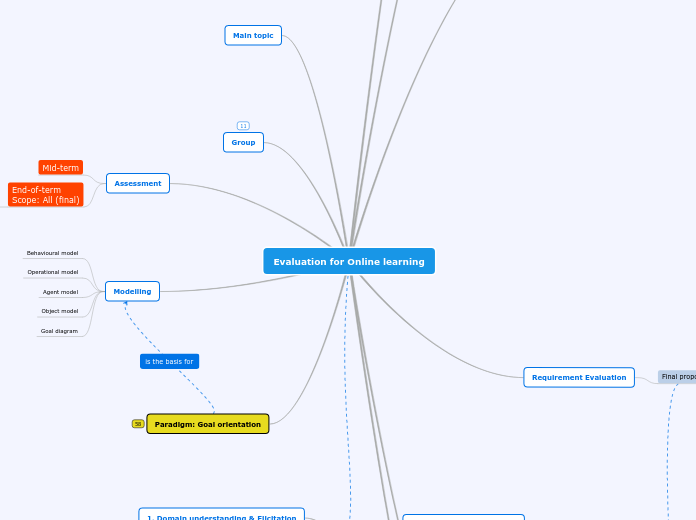Evaluation for Online learning
Main topic
RE
Requirement Elicitation
Artifact-driven techniques
background study
Collect, research and synthesize about the client (in this situation is the school).
Research and report about other platforms that have similar domains (online study platform): Coursera, UET courses, ViettelStudy,..
Build the document of the system-as-is : workflow, business rules, defect/complaint reports, update, change request.
Make sure to have the right and sufficient info, not more or less on how and what client and user want in order to evaluate the platform
Prepare basic info about the client (VNU), what is the inadequacies of online learning, their goal for this platform
questionnaires
Create survey question for client, user student and teacher
data collection
Collect data about the number of students and teachers who have to join learning courses, number of courses, estimate the request per second.
Research about the requirement of the performance, usability, cost, security,.. How many users will access the system at one time, how security could the system be?
prototyping
Quick implementation of some aspects, focus on specific functions like creating courses, registering to the courses, … to get feedback from real users.
Stakeholder-driven techniques
Interview
Student
Teacher
Education expert
Domain Analysis
Preliminary proposal (draft)
System as-is
System to-be
Glossary of terms (Definitions)
Requirement Evaluation
Final proposal
Inconsistency management
Types of inconsistency
Teminology Clash
Designation clash
Strong conflict
Weak conflict
Handling inconsistencies
Conflict management
Risk analysis
Risk
Likelihood of occurence
Undesirable consequences
Likelihood of occurence if the risk occurs
Severity
Risk types
Product-related
Functional Risks
Non-Functional Risks
Process-related
top 10 risks [Boehm, 1989]
Risk management (RM)
Identify
Product-related
Process-related
Risk tree
Assess
Qualitative
Quantitative
Control
Counter measures (CMs)
Explore
Evaluate + Select
FRs
NFRs
Cost-effectiveness
RRL
Risk documentation
Annotated risk tree
Integrating RM into RE (DDP)
Alternative option evaluation
Qualitative
NFRs
Level labels
Quantitative
Weighted matrix
Criteria weights
Option weighted score
Requirements prioritisation
Value-cost prioritisation
AHP technique
Criteria: value, cost
Build comparison matrix
Determine how value, cost
distribute among Reqs
value-cost diagram
Requirement specification
Requirement document (RD)
RD template:OR
IEEE
Volere
styles
free NL
structured NL
template
Diagrams
formal specification
Requirement QA
Inspection and review
Querying specification db
Requirement validation by spec animation
Formal checking
Outputs
Consolidated RD
Others
Group
Assessment
Mid-term
End-of-term
Scope: All (final)
Report
Modelling
Behavioural model
Operational model
Agent model
Object model
Goal diagram
